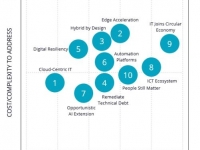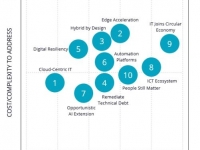Technology
THE COVID EFFECT PART TWO: CRYSTAL BALL PREDICTIONS FROM IDC
2021 TECHNOLOGY TRENDS PART 2 OF 3

Looking into the Crystal Ball for 2021 (Source: Photo by Yeshi Kangrang on Unsplash)
USPA NEWS -
As mentioned in part one of this series of reports, as the world starts to get to grips with the COVID pandemic and a new United States President takes the reins of power in his first 30 days, here are a few more things to look out for in the technology world according to the second of 'The Big Three' technology analyst firms. In this report we look at IDC. As an analyst firm, they are strong on market numbers, and many of their clients see them as the go-to firm for market shares and future market grow assessments. This is part two of a three-part series that has already covered Gartner´s predictions and will lead on to Forrester´s in part three.
IDC TOP PREDICTIONS
Most analyst firms love charts. IDC is no exception, and has a has a very easy-to-read “FutureScape“ which covers “Worldwide IT Industry 2021 Top Predictions“. IDC has ten predictions which they position on their chart with their timing on the x-axis, and cost on the y-axis. As before, I´m going to focus on three of the ten that caught my eye and are directly COVID related.According to Rick Villars, group vice president, Worldwide Research, IDC, "The COVID-19 pandemic highlighted that the ability to rapidly adapt and respond to unplanned/unforeseen business disruptions will be a clearer determiner of success in our increasingly digitalized economy. A large percentage of a future enterprise's revenue depends upon the responsiveness, scalability, and resiliency of its infrastructure, applications, and data resources."
Here are predictions #1, #2 and #5 out of the ten which I wanted to bring out as truly COVID-19 relevant:
Prediction #1
“By the end of 2021, based on lessons learned, 80% of enterprises will put a mechanism in place to shift to cloud-centric infrastructure and applications twice as fast as before the pandemic“.
Here IDC say their research points to their view that “the transition to cloud-centric digital infrastructure, which was already underway, will accelerate following the pandemic. It is clear that a large percentage of a digital enterprise's revenue depends upon the responsiveness, scalability, and resiliency of its infrastructure, applications, and data resources“. Clearly IDC is seeing what I´ve researched: that necessity is the mother of invention. Remote working, virtual meetings and online schooling added to the urgency, with an explosion of web commerce ““ both business-to-business and business-to-consumer - that made this as urgent as the development of a vaccine if businesses and institutions were to survive.
Prediction #2
“Through 2023, reactions to changed workforce and operations practices during the pandemic will be the dominant accelerators for 80% of edge-driven investments and business model changes in most industries.“
With this prediction IDC point out that navigating the current COVID-19 influenced business environment ““¦requires an increased focus on the deployment and operation of IT resources in dispersed edge locations that are proving vital to many businesses“. This is where new innovations such as IoT, robotics, autonomous vehicles and the like come to the forefront. All especially relevant to healthcare, manufacturing and even transportation, despite the later industry´s current slowdown. IDC sees this prediction as perhaps the costliest in terms of resources and complexity to address. and most prevalent in 2-3 years´ time.
Prediction #5
This one struck a chord with me based on my own research: “In 2022, enterprises focused on digital resiliency will adapt to disruption and extend services to respond to new conditions 50% faster than ones fixated on restoring existing business/IT resiliency levels“.
Here IDC touch on the hard lessons learnt from the start of the pandemic ““ the massive shift to remote working, to ““¦the radical changes in the wants, needs, and behaviors of customers and more“. IDC notice that corporate and government teams are dispersed, workers need to work more autonomously, and, I will add, all need increased security as well as resiliency. IDC points out: “Leading enterprises will focus more on digital resiliency. They can rapidly adapt to business disruptions, leverage digital capabilities to maintain continuous business operations, and quickly adjust to take advantage of changed conditions for competitive advantage“.
Full list of predictions
The ten IDC predictions list with full information is available as a free download (with registration) on the IDC website as Doc# US46942020. A summary of the ten predictions is provided below:
Prediction 2: Through 2023, reactions to changed workforce and operations practices during the pandemic will be the dominant accelerators for 80% of edge-driven investments and business model changes in most industries..
Prediction 3: By 2023, 75% of G2000 companies will commit to providing technical parity to a workforce that is hybrid by design rather than by circumstance, enabling them to work together separately and in real time.
Prediction 4: Through 2023, coping with technical debt accumulated during the pandemic will shadow 70% of CIOs, causing financial stress, inertial drag on IT agility, and "forced march" migrations to the cloud.
Prediction 5: In 2022, enterprises focused on digital resiliency will adapt to disruption and extend services to respond to new conditions 50% faster than ones fixated on restoring existing business/IT resiliency levels.
Prediction 6: By 2023, an emerging cloud ecosystem for extending resource control and real-time analytics will be the underlying platform for all IT and business automation initiatives anywhere and everywhere.
Prediction 7: By 2023, driven by the goal to embed intelligence in products and services, one quarter of G2000 companies will acquire at least one AI software start-up to ensure ownership of differentiated skills and IP.
Prediction 8: By 2024, 80% of enterprises will overhaul relationships with suppliers, providers, and partners to better execute digital strategies for ubiquitous deployment of resources and for autonomous IT operations.
Prediction 9: By 2025, 90% of G2000 companies will mandate reusable materials in IT hardware supply chains, carbon neutrality targets for providers' facilities, and lower energy use as prerequisites for doing business.
Prediction 10: Through 2023, half of enterprises' hybrid workforce and business automation
efforts will be delayed or will fail outright due to underinvestment in building IT/Sec/DevOps
teams with the right tools/skills.
efforts will be delayed or will fail outright due to underinvestment in building IT/Sec/DevOps
teams with the right tools/skills.
Conclusions
The IDC study referenced discusses the top 10 predictions and key drivers for the IT industry not just for 2021, but “for the next five years“. While it “highlights the midterm and long-term challenges that enterprise IT teams face as they navigate their ongoing response to the business disruptions triggered by the COVID-19 pandemic and seek to gain competitive advantage in the next normal“, I believe it has broader implications than that. The areas of discussion have wide implications outside of IT. All functions and departments of many organizations, in both public and private sectors, will be impacted. IT will need to be far more integrated into the mainstream of most organizations, seen not as an historical cost center, but as a means of driving growth, employment, security and collaboration throughout the organization.more information: https://www.idc.com/getdoc.jsp?containerId=US46942020
Liability for this article lies with the author, who also holds the copyright. Editorial content from USPA may be quoted on other websites as long as the quote comprises no more than 5% of the entire text, is marked as such and the source is named (via hyperlink).








